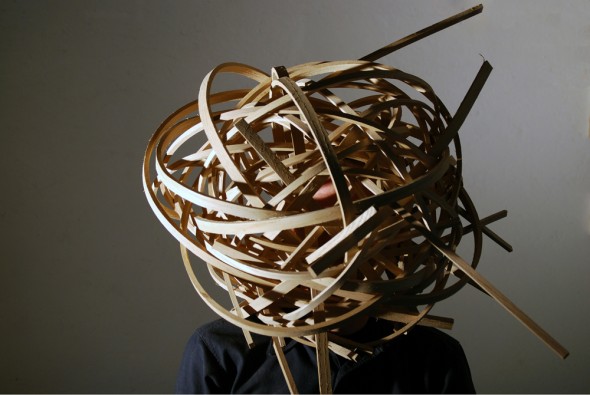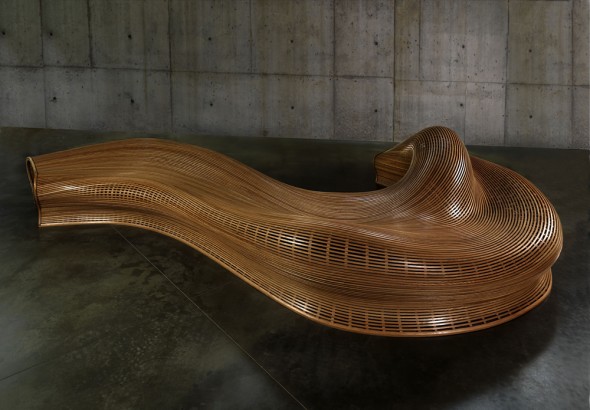
Form, Function and Physics
The word “Amada” in Spanish is a term of endearment between lovers suggesting intimacy and physical closeness. The two are intertwined, familiar with the curves and bends of each other, yet discovering them over and over.
Amada is also the name of furniture designer Matthias Pliessnig’s signature piece, a 27-foot-long bench made of strips of bent white oak. Meticulously assembled by employing a kind of labor-intensive coopering that involves steam bending thin strips of wood, the piece reflects Pliessnig’s attention to form, function and physics. He is an artist whose art is informed by a boyhood imagination that envisioned the construction of boats and airplanes. Fast-forward to art school, where that drive met a desire not to just dictate the aesthetic of a piece but to show the artistry of how it actually came to take on that form in the first place.
“My first influence is process,” he explains. “Then human interaction and space interaction. The outcomes are forms that meander through space, keeping in mind aerodynamics and hydrodynamics.”
The peaks and valleys of Amada wrap around the body with conspicuous familiarity, yet never quite give up the mystery of how the experience between object and individual will unfold. The bench, along with seven other pieces, is now part of an exhibit at the Smithsonian’s Renwick Gallery of American Art, where Pliessnig is among just four artists featured in its annual Renwick Craft Invitational. Supplementing his contributions to the show are printed computer models of additional work as well as a “hands on” piece—a knotted ball of steam-bent wood that the public can touch. “The narrative,” he says, “represents my general body of work.”
In high school, Pliessnig’s art teacher took note of his simultaneous efforts to create a design through the very process of constructing a piece. He suggested art school and after a brief stint at the Kansas City Art Institute, Pliessnig, now 32, enrolled in a furniture design program at the Rhode Island School of Design, which he followed up with an MFA at the University of Wisconsin-Madison. He began with metal sculpture and then moved on to wood when a teacher introduced him to coopering, or the process of bending wood, such as done with barrel or cask making.

Amada, Steam bent white oak 276” x116” x 34”, 2010. Photo by Gene Young
Using that process, he went on to build a boat, “in part to just go through the actual process of making it,” he says. It now hangs from the ceiling of his workshop in a formerly industrial neighborhood of Philadelphia that now provides affordable raw space to a number of emerging artists and designers. A New York Times reporter quipped that his studio looked more like a “boat builder’s garage than an icy SoHo loft.”
Most of Pliessnig’s designs are for sitting or reclining and he refers to his style as “kinetic contemporary.” The pieces undulate effortlessly around the human form like one of the elements. Making them look that way is a time-consuming and exacting process.
Using thin strips of wood that have been air-dried (“You can’t just steam any wood,” he says. “Wood that is kiln-dried is no good.”), Pliessnig inserts the strips into a long pipe. At around 300 degrees Fahrenheit, the steam begins to soften the resins in the wood fiber. After approximately 15 minutes the strips are pliable and can be shaped. Pliessnig has about 30 seconds to get through the shaping process before the wood begins to harden again. Once set, the strips are held in their position for about six to eight hours.
Pliessnig maintains his stock of air-dried wood by networking with local farmers and boat builders who keep it in supply for their own uses. He often employs white oak in his pieces for its combined qualities of malleability and strength.
Sought after by private collectors and architectural firms from New Zealand to New York, Pliessnig is working on several commissioned pieces. But he’s looking forward to some new experimentation time thanks to a recent $50,000 fellowship from the organization United States Artists (USA). He’s been winning accolades since graduate school and was selected for the Joan Mitchell Award (in honor of the American abstract expressionist) while at the University of Wisconsin-Madison. In 2009 he received the Louis Comfort Tiffany Award for emerging American artists.
His current commissions include a large bench for a private residence, a lighting structure held together with copper rivets which, he explains, “should resemble an explosion of twisted wood in the end.” He’s also working on an outdoor bench for a public space in Rhode Island. A $5,000 supplement to the base award from USA will help him develop and fund workshops for young artists.
When Pliessnig talks about his design “vocabulary,” or range of work that he produces, he sounds like part artist, part rocket scientist. When he says process is an influence, he literally means each step necessary to create shapes that will compliment the dynamics of human form and serve as functional furniture. He doesn’t seek to be influenced by trends. It’s one of the things he likes about his current geography—close enough to the New York galleries but far enough away to avoid the claustrophobia of “inspiration.” His inspiration is his own need to simply figure out how things work and what kind of art can be born from the process of making. He also gets ideas from various architectural forms and cites his adopted city as a rich source of examples. “I have spent a lot of time walking around this city taking pictures of different buildings.”
A large piece, such as Amada or his other large bench, Providence, consists of tens of thousands of intersections between wood strips. Pliessnig typically spends about 14 hours a day in his studio, and that’s with someone to assist him. A project like Amada may take five months to complete, while smaller pieces may take anywhere from three to six weeks. The end result is often dictated by what happens as it’s made, specifically how bodies working on the piece have to move around it to continue building it. “As a result,” Pliessnig says, “the body has an impact on how it’s made.”
– Angelina Sciolla

